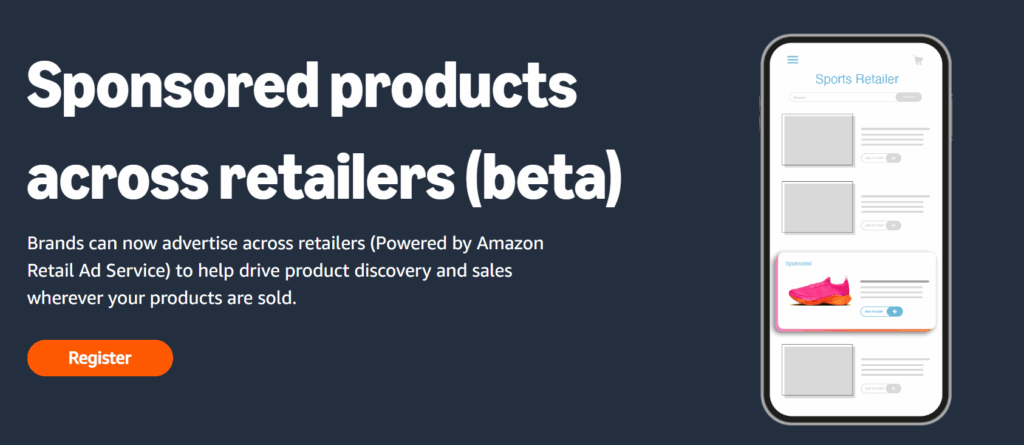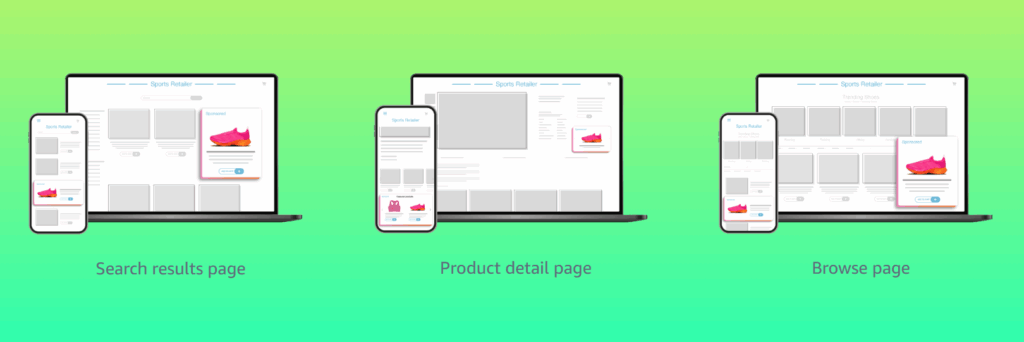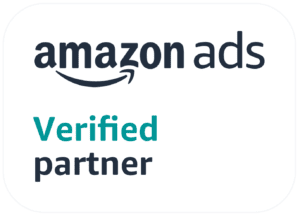
Most Amazon sellers don’t rely solely on Amazon. Many operate their own e-commerce sites, sell through other marketplaces, and partner with third-party retailers to stock their products. However, one common thread among nearly all Amazon sellers is their use of Sponsored Product ads. These ads are a fundamental part of Amazon’s advertising system, playing a key role in boosting product visibility and driving sales in a crowded marketplace.
Now, Amazon is looking to take that success even further. With its Sponsored Products Across Retailers (Beta) program, Amazon is offering brands the chance to promote their products on external retailer websites and apps, even for items not listed on Amazon. The big question: Is this just another money-making move by Amazon, or a genuine new opportunity for sellers? Let’s dig into the details.
What is Sponsored Products Across Retailers (Beta)?

Sponsored Products Across Retailers (Beta) is Amazon’s latest expansion of its Sponsored Products ad format, designed to extend advertising reach beyond Amazon’s platform. This feature enables sellers to place ads on the websites and apps of participating third-party retailers, even if they don’t list their products on Amazon.
How it works
- Retailer selection – During campaign setup, you can choose which retailer’s site your ads will appear on.
- Retailer-based listings – Ads feature items from the retailer’s own product catalog, not from Amazon’s listings.
- Integrated ad placements – Ads are displayed in natural placements such as search results, category pages, and product detail pages.
- External checkout – When a shopper clicks on an ad, they’re taken to the retailer’s site or app to complete the purchase, not Amazon.
Who is eligible?
Brands that sell on any of the participating retailer platforms can take part.
You don’t need to be an Amazon seller to use this feature, but you must have an Amazon Ads account.
Why it’s important?
Sponsored Products have long been a go-to tool for boosting visibility and conversions on Amazon. With this beta, Amazon is giving sellers the chance to tap into that same success across a wider digital landscape, meeting consumers where they already shop. But is it a smart move for your brand? Let’s take a closer look.
Why is Amazon expanding Sponsored Products beyond its platform?
Amazon’s decision to offer Sponsored Products on external retail sites isn’t just an act of goodwill; it’s a calculated strategy that benefits Amazon, its advertisers, and the retailers involved. Here’s why this move is a smart play:
1. Boosting Amazon’s ad revenue
Amazon’s advertising division is a major contributor to its overall earnings, and Sponsored Products are among its top-performing ad formats. By allowing these ads to run on third-party retail sites, Amazon can earn from ad clicks and impressions even when purchases don’t happen on its platform. More exposure means more clicks and more profit for Amazon.
2. Retaining advertisers in the Amazon Ads ecosystem
Sellers aren’t limited to Amazon; they also sell on platforms like Walmart, Target, or through their own sites. Instead of losing those ad dollars to platforms like Google Ads, Meta, or TikTok, Amazon is offering a way for sellers to continue investing in Amazon Ads, no matter where they sell.
3. Supporting retailers while profiting from them
Retailers who join this program gain access to Amazon’s highly sophisticated advertising tools, allowing for better targeting and increased revenue. It’s a win for them, but also for Amazon, which essentially monetizes its competitors while maintaining control of the ad platform and user data.
4. Expanding Amazon’s influence in the ad space
Amazon’s advertising platform is powered by advanced algorithms and machine learning. By broadening its ad reach to other retail websites, Amazon reinforces its presence in the digital ad market, positioning itself more strongly against giants like Google, Meta, and TikTok for a larger share of e-commerce ad spending.
What does this mean for sellers?
This expansion isn’t just another feature, it signals a broader shift in Amazon’s advertising direction. The real question for sellers is whether this opportunity will drive more sales, or simply lead to higher ad costs. Up next, we’ll explore how the program works and what it means for your brand.
How does it work?
Amazon has taken the proven success of its Sponsored Products ads and extended the same technology to external retail sites and apps. Here’s a breakdown of how the system operates:
1. Choose your advertising destination
When creating a campaign, you can pick which participating retailer(s) you want your Sponsored Product ads to appear on.
Unlike traditional Amazon ads, these don’t link to your Amazon listings. Instead, they highlight products directly from the selected retailer’s catalog.
2. Ads are integrated into retailer platforms
Your ads will appear in natural, high-visibility spots like search results, category pages, and product detail pages on the retailer’s website or app.
Retailers control the visual presentation of the ads, ensuring they match the look and flow of their own shopping experience.
3. Shoppers complete purchases off Amazon
When someone clicks on your ad, they’re taken to the product page on the retailer’s site, not Amazon.
The transaction is finalized on that retailer’s platform, just as if the shopper had found the product organically.
4. Familiar ad management process
You set up and manage these campaigns through Amazon’s ad console or API, just as you would for ads on Amazon.
You have access to automated or manual keyword targeting, adjustable bids, daily budget controls, and performance tracking tools, mirroring the typical Sponsored Products setup.
Key differences from Amazon’s Sponsored Products
| Feature | Sponsored Products on Amazon | Sponsored Products Across Retailers |
| Ad Placement | Shown on Amazon search results and product pages | Displayed on search results and product pages of other retailers’ sites and apps |
| Purchase Location | Checkout occurs on Amazon.com | Shoppers complete their purchase on the retailer’s own website or app |
| Promoted Products | Ads promote your listings on Amazon | Ads feature items from the retailer’s own product catalog |
| Placement Control | Amazon manages where the ads appear | The external retailer determines how and where the ads are shown |
Who can use it?
Amazon’s Sponsored Products Across Retailers (Beta) isn’t available to everyone, there are specific criteria brands must meet to participate. Here’s who qualifies:
1. Sellers with products listed on participating retail sites
You must already have your products available on the retailer’s online store or app to advertise through this program.
These ads don’t link to your Amazon listings, they promote items from the retailer’s own product catalog.
2. Advertisers with an Amazon Ads account
Although these ads don’t run on Amazon.com, having an active Amazon Ads account is required to access and manage them.
If you’re familiar with Amazon’s Sponsored Products, navigating this setup should feel intuitive.
3. Brands selling beyond Amazon
If your business spans across platforms like Walmart, Target, or Best Buy, this program lets you advertise on those sites while still using Amazon’s ad infrastructure.
It’s also a great opportunity for brands that don’t sell on Amazon at all but want to tap into Amazon’s robust ad tools for visibility elsewhere.
Who Isn’t Eligible (Yet)?
- Amazon-only sellers – If you only sell your products on Amazon and don’t list them on any participating external retailers, you won’t be able to use this feature.
- Retailers not in Amazon’s beta program – Currently, only select U.S.-based retailers are part of the pilot phase. Others will have to wait.
- Sellers without an Amazon Ads account – Access to Amazon’s ad console is mandatory to launch and manage these campaigns.
What This Means for Sellers
If you already have products listed with one of the partnered retailers and you use Amazon Ads, this feature could offer an easy way to extend your brand’s presence. But if you’re only selling on Amazon, you’ll need to expand to other platforms before this option becomes available to you.
Where do these ads appear?

With Amazon’s Sponsored Products Across Retailers (Beta), ads are embedded directly into the shopping experience of partner retail sites. These are not pop-ups or traditional display banners, they’re seamlessly integrated into key shopping areas, mimicking the look and feel of native listings, just like Amazon’s Sponsored Products.
1. Search Results Pages
Your ads can appear when customers use a retailer’s search function to look for products.
These placements are similar to Amazon’s Sponsored Product ads, usually found at the top of search results or scattered throughout the page.
This ensures strong visibility at the exact moment shoppers are looking for related items.
2. Product Detail Pages
Just like on Amazon, your ads may show on the product pages of similar or competing items.
This gives your product a chance to be discovered as a comparable or better alternative while a shopper is evaluating another product.
Keep in mind: individual retailers control where and how these ads display, so placements may not be uniform across platforms.
3. Browse and Category Pages
Your ads can also surface while customers are exploring categories or departments without searching for a specific product.
This helps introduce your brand to new customers who are in discovery mode and not yet committed to a particular item.
Retailer-Managed Ad Placements
Unlike Amazon, where ad placements follow standardized rules, participating retailers determine how and where ads appear on their platforms. This means:
- Each retailer has its own approach to ad integration.
- Visibility levels can change based on page layout, traffic, and advertiser competition.
- Some retailers may prioritize in-house brands, which could impact third-party ad exposure.
Since the control is in the retailer’s hands, placements may be less predictable than on Amazon. However, when campaigns are properly optimized, this program still offers a powerful way to reach potential buyers where they’re actively browsing and shopping.
Next, let’s take a closer look at whether this initiative truly benefits sellers or simply gives them another way to spend on advertising.
Potential benefits for Amazon sellers
For brands managing Amazon PPC campaigns themselves or working with a dedicated Amazon PPC management agency, the Sponsored Products Across Retailers (Beta) program presents fresh opportunities beyond Amazon’s marketplace. Here’s how sellers might benefit:
1. Wider Exposure With Minimal Learning Curve
If you’re already familiar with Amazon PPC advertising management, this feature expands your reach to additional retail sites, without needing to master a new advertising platform. Everything is still handled through the Amazon Ads console, keeping operations streamlined.
2. Utilize Amazon’s Ad Capabilities on External Sites
Amazon’s advanced ad technology, powered by its machine learning systems, is now available for campaigns that run outside of Amazon. Sellers can continue to benefit from Amazon’s smart targeting, bidding strategies, and optimization tools even when advertising on third-party retail sites.
3. Reach Customers Across Multiple Marketplaces
If your products are listed on other online retailers such as Best Buy, Target, or Walmart, this program allows you to consolidate your advertising efforts under one system. You won’t need to juggle different ad managers for each site, Amazon’s ad platform lets you manage it all in one place.
4. Get Ahead With Early Access
Because this program is still in its testing phase, fewer sellers are participating. This creates a temporary advantage: lower cost-per-click (CPC) rates and better visibility. Joining early could position your brand ahead of competitors before the space becomes saturated.
Overall, this beta program provides sellers with a new way to extend their reach, increase efficiency, and potentially lower ad costs, while leveraging tools they already use.
Possible drawbacks and limitations
While Amazon’s new ad expansion might look like a straightforward growth opportunity, there are some real challenges that sellers and Amazon PPC experts should keep in mind:
1. Lack of Placement Control
On Amazon, Sponsored Product ads have predictable placements. That’s not the case here, each participating retailer decides where and how ads are displayed. This could mean your ad is shown in less visible spots, affecting its performance.
2. Limited Transparency and Reporting
Because these ads appear on external retail websites, you may not receive the same level of detailed reporting or real-time data that you’re used to with Amazon PPC campaigns. This can make tracking, adjusting, and optimizing performance more difficult.
3. Varying Customer Intent
Amazon shoppers typically visit the site ready to purchase, but customers on other retail platforms might just be browsing. This difference in buying intent could result in lower conversion rates, even with well-targeted ads.
4. Not Suitable for Amazon-Only Sellers
If your products are only available on Amazon, this feature isn’t for you. It’s designed for businesses already listed on other retail sites and looking to enhance visibility there. Sellers limited to Amazon won’t benefit from this ad format.
Should You Try It?
If your brand is listed across multiple online stores and you’re open to experimenting, this could be a low-barrier way to expand visibility using a familiar ad interface. But if your priority is precision control, deep analytics, and tight budget management, it might be wise to hold off until Amazon releases more specifics.
Before jumping in, consult with Amazon consultants who can assess your strategy and determine if this beta opportunity aligns with your broader sales goals.






